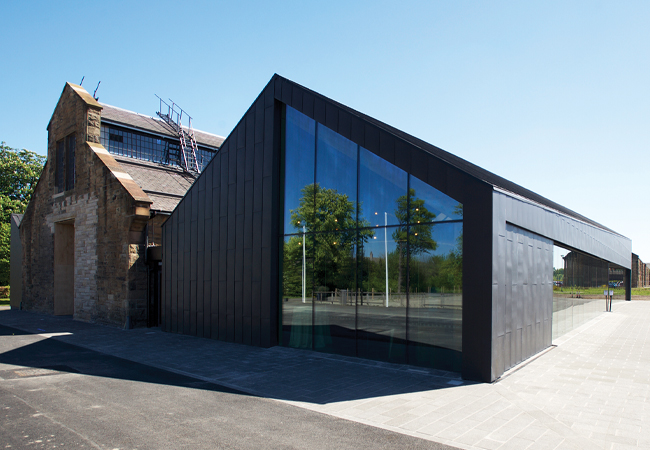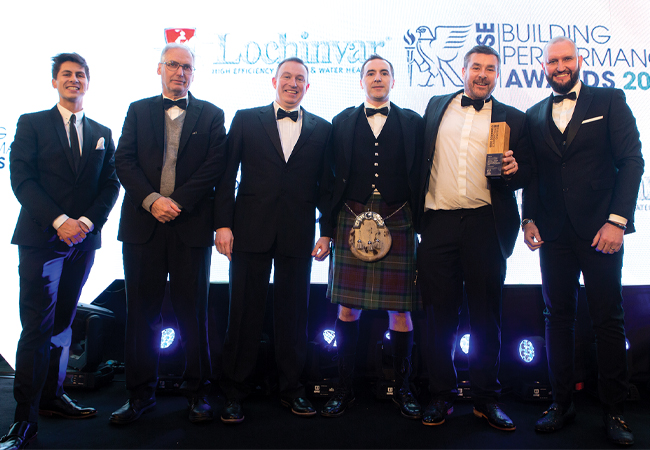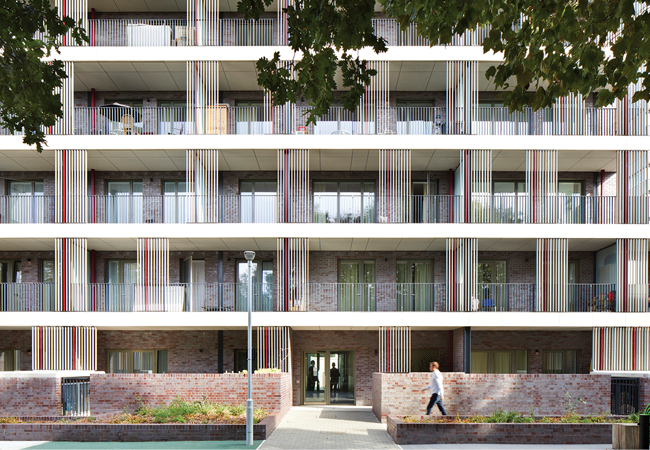
Max Fordham and BuroHappold Engineering were the standout winners at the CIBSE Building Performance Awards at Grosvenor House hotel in London last month.
As well as scooping the Project of the Year – Residential award for the Agar Grove Estate regeneration, Max Fordham won Project of the Year – Public Use for The Engine Shed, Scotland’s building conservation centre.
The consultancy was also crowned Building Performance Champion for The Engine Shed (see our feature on page 32). The judges, chaired by CIBSE technical director Hywel Davies, recognised Max Fordham for its extremely thorough attention to detail and commitment to a two-year aftercare period. They were impressed by the project’s rounded approach to sustainability – taking in material, energy and human aspects – and the long-term view of the development.
As well as winning the Project of the Year – Retrofit category for Bartlett School of Architecture, 22 Gordon Street, BuroHappold Engineering picked up the trophy for Building Performance Consultancy (over 300 employees).
BuroHappold Engineering associate Tom Hopton was crowned Building Performance Engineer of the Year. Having worked at the consultancy since 2015, Hopton has been the lead engineer for many award-winning projects with innovative design at their core – from the UK’s first large-scale horse-manure biomass system to the restoration of a 900-year-old building into a modern training campus.
On the evening of the awards, hosted by magician Ben Hanlin, guest speaker Yewande Akinola, of Laing O’Rourke, talked about the power of engineers to the 680-strong audience. As engineers, she said, we have the power to ‘shape a better world and improve the quality of our environment’.
‘Whether it’s buildings or the built environment in the Far East – or in this country or in the Middle East – we are literally shaping the future of our world, and technology is paving the way for this. We are the game changers,’ Akinola added.
However, she believes engineers need to become campaigners for the changes we need to see, and show ‘the clients, the kids and the Gretas that we’ve got this’. She added: ‘We need to shape the future of our buildings and environment by combining creativity and engineering, to get to a place where we can say to children: we have done our very best.’
Akinola also stressed the importance of diverse teams that ‘reflect the societies that we serve’ to make these changes.
‘We live in incredible times,’ she said, ‘and engineers are at the heart of it. I am hopeful for the future – and I hope you are inspired to step into the light and change towards creating and shaping that sustainable, exciting, creative world that we all deserve, and our children deserve.
Winner: The Engine Shed – Max Fordham The Engine Shed is Scotland’s new building conservation centre, and is housed in a redundant Ministry of Defence train shed with new-build wings. Traditional skills and natural, low carbon materials, such as stone and reclaimed timber, were used in the construction, while passive design measures, including natural daylighting and natural ventilation, help provide a healthy, comfortable environment. Judges said Max Fordham showed extremely thorough attention to detail and a commitment to a two-year aftercare period, and that the building’s sustainability matrix, soft landings, building user guide and quarterly reporting were exemplar. The post-occupancy evaluation at the end of year one showed that high comfort levels had been achieved in practice as well as design, and these were improved by monitoring temperature and CO2 levels in the aftercare period. Sponsored by Baxi HeatingBuilding Performance Champion and Project of the Year – Public Use


Building Performance Consultancy (up to 50 employees)
Winner: Noel Lawler Green Energy Solutions (NLGES)
The Ireland-based consultancy worked with a biomass boiler specialist to convert heat from poultry droppings to electricity, with excess heat used to warm the hen houses. This resulted in reduced energy consumption, better bird welfare, less pollution, and an improved business case for farmers. The judges were also impressed by NLGES’s inclusion of biophilic elements in its head office in Kilkenny, and by its investment in staff training.
Sponsored by: Rinnai UK

Building Performance Consultancy (up to 51-300 employees)
Winner: Elementa Consulting
Elementa collaborates internally through open-office brainstorming sessions and presentations, and externally through workshops, BIM planning sessions, and technical discussions with non-technical people. The judges felt that the consultant’s Performance Hour soft landings workshop showed its ‘clear commitment to client betterment’.
They said Elementa showed R&D in challenging areas, including post-occupancy evaluation, building performance, corporate social responsibility, and wellbeing. It also shared a commitment to reducing energy use.
Sponsored by: Imtech

Building Performance Consultancy (over 300 employees)
Winner: BuroHappold Engineering
BuroHappold shares its expertise as a delivery partner for the Design for Performance (DfP) initiative, while its global Building Performance Group holds regular events to share best practice internally. Its ‘Hackademy’ also prepares engineers to make best use of the data generated by BIM technologies.
An example of BuroHappold’s post-occupancy evaluation work is the partnership with Newcastle University Urban Sciences Building, where open-access and real-time data from the BMS has been embedded into the BIM model, used as a ‘living lab’ for research and FM.
Sponsored by: ABB

Collaboration
Winner: ESFA School Building Framework Project – Bowmer + Kirkland/Integrated Environmental Solutions
The main contractor and building performance analysis consultant worked with a BMS controls subcontractor to tackle the performance gap. They refined the way data was collected and transmitted from several ESFA schools, to achieve more granular operational insights.
The team used this to create energy profiles, which could be fed back into the IES Virtual Environment building simulation software. By integrating iSCAN, this collaboration brought real-world data into the existing model for cross-comparison and validation that the buildings did operate as intended.
Sponsored by: Lochinvar

Learning and development
Winner: HVAC Centre of Excellence – Air Conditioning and Mechanical Contractors’ Association and Holmesglen
The main contractor and building performance analysis consultant worked with a BMS controls subcontractor to tackle the performance gap. They refined the way data was collected and transmitted from several ESFA schools, to achieve more granular operational insights.
The team used this to create energy profiles, which could be fed back into the IES Virtual Environment building simulation software. By integrating iSCAN, this collaboration brought real-world data into the existing model for cross-comparison and validation that the buildings did operate as intended.

Winner: Yale-NUS College The 14-strong Infrastructure, Safety and Security Office – supported by outsourcing partners – is responsible for facilities management at the Singapore-based college, which has about 1,200 staff and students. QR codes have been placed around the campus so security officers on patrol can report defects using a GPS tracking system. In the past two years, the college has reduced the average defect turnaround time from 5.57 days to 0.73 days. The college also monitors energy consumption via a suite of meters across the campus, and educates students and staff about thermal comfort in a shared zone. Sponsored by The Gratte BrothersFacilities management

Product or Innovation – Thermal Comfort
Winner: Hysopt HVAC Design and Optimisation Software
Hysopt’s winning HVAC Design and Optimisation Software accomplishes the feat of optimising cooling and heating systems design to deliver energy savings. The judges appreciated that the product is scalable, has wide application, and can link to thermal modelling tools.
On average, Hysopt’s software unlocks a yearly energy saving of 30-40%, with an investment payback of between one and five years. Very often, minimal adjustments give savings of up to 15-20% without requiring capital expenditure.

Product or Innovation – Wellbeing
Winner: arbn well – arbnco
Arbn well is the first high-density indoor environmental quality sensing service dedicated to health and wellbeing, for use in new and old offices, homes, hospitals, schools and universities. A network of sensors measures temperature, relative humidity, CO2, total volatile organic compounds, particulate matter and light levels, and communicate over a private network using an improved version of LoRa.
Real-time information is provided to building managers, and reports are generated automatically to identify long-term issues and trends in the building performance.
Sponsored by: Tamlite Lighting

Project of the Year – Retrofit
Winner: Bartlett School of Architecture, 22 Gordon Street – BuroHappold Engineering
The judges were impressed with the pre- and post-occupancy evaluation (POE) of the £22m refurbishment of University College London’s 22 Gordon Street. This helped BuroHappold achieve a 60% reduction in energy use per m2 – despite the usable floor area of the building increasing by more than 40% and greater environmental control being provided.
The building’s Display Energy Certificate rating improved from G to D, and Building Use Studies showed that staff and students were most satisfied with the design of the building.

Project of the Year – Commercial/Industrial
Winner: Institute of Physics – Aecom
Aecom’s accessible Institute of Physics integrates several cutting-edge systems, including a geothermal closed-loop borehole, plus oversized free cooling ventilation combined with adaptive internal setpoints.
Set in a conservation area on the edge of London’s ‘Knowledge Quarter’, the building features ‘chimneys’ that replicate Victorian stacks, to take in fresh air at a high level and discharge it up through a central atrium. The building’s thermal mass mitigates peak temperatures and sets adaptive comfort criteria during peak summer conditions.
Sponsored by: Hattersley

Project of the Year – International
Winner: Mason Bros, Auckland, New Zealand – Mott MacDonald
Mason Bros – a 1920s former warehouse beginning its second life as a key part of Auckland’s Wynyard Quarter Innovation Precinct – incorporates passive design features, including: exposed thermal mass; natural ventilation; large south-light glazing; and a balanced window-to-wall ratio to maximise daylight while minimising fabric heat gains.
The building’s carbon emissions are 9.5 kgCO2/m2, and it benefited from an 18-month tuning and commissioning programme after practical completion.
Sponsored by: CIBSE Patrons

Winner: Agar Grove Estate Regeneration: Phase 1A – Max Fordham
The £11.5m first phase of Camden’s largest community investment project comprises 38 social-rented homes, and more than 90% of the estate residents were engaged in commenting on the proposals.
The M&E design brief focused on reducing residents’ fuel bills, cutting carbon, and minimising maintenance requirements. A logical extension of this approach was the Passivhaus (PH) standard, using fabric-first design to reduce heat losses and to model building performance more accurately.
Sponsored by: Titon Hardware


